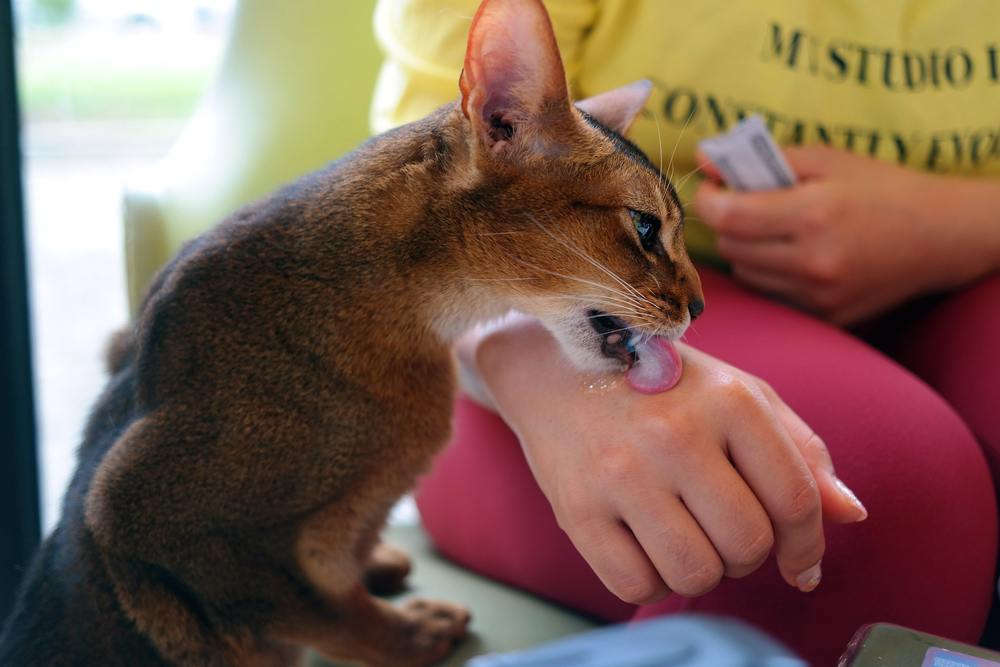
Taking on the responsibility of caring for a new cat is a rewarding and exciting endeavor. However, much like people, cats all have different personalities, and making friends can be harder for some than others. As a veterinarian and cat lover, I’ve worked with all kinds of cats over the years, and I even own a very nervous cat myself.
Socializing a shy, nervous cat, especially in a new home, takes time and a lot of patience. Providing your new pet with one or two private and safe places, ensuring as many positive interactions as possible, and refraining from loud noises and sudden movements are all key in helping a fearful cat become best friends with you.
Also Read: 8 Ways to Help a Scared and Fearful Cat Be Confident
Cats may be nervous in a new home for all sorts of reasons, from poor socialization to previous bad experiences, or just their own unique personality. Shy cats should be provided with hiding places, a quiet and predictable household routine, pheromone support, and some time and patience to adjust. Slowly introduce playtime and gentle touch, ensuring all interactions are positive by watching for your cat’s communication cues.Key Takeaways
Signs of a Nervous Cat
Cats may be nervous or shy for all sorts of reasons. Cats adopted from a humane society or shelter, or those who started their lives as feral cats, may have had poor levels of socialization with humans in their kitten stage. This often makes them unsure of new situations or less socially confident as an adult cat.
Some cats may also just have quieter personalities than others. They may also be generally nervous or less confident when placed into a new environment or when meeting new people. Some kitties may have had bad experiences in the past, leaving them more cautious of future interactions.
Common signs that your cat is nervous:
- Hiding away
- Tense, crouched posture
- Dilated pupils
- Frequent vocalizations
- Not eating well
- Toileting outside the litter tray
- Hyper-vigilant, startles easily
These signs still all point to normal behavior for a cat placed in a new environment and should improve as your pet settles in. However, if an established cat suddenly shows signs of stress, it is best to get them checked out by a veterinarian.
8 Steps to Befriending a Scared Cat

Allow a shy cat to come to you and learn that you are not a threat and so they can relax around you.
The good news is that there are plenty of things that cat owners can do to support their shy cat. Here are eight steps to help you if you’ve welcomed a nervous housecat into your life.
1. Provide a Safe Space
The first essential step to gaining your cat’s trust is to provide them with a safe hiding place. Ideally, give them more than one. It is normal for any cat to want a safe space to retreat to when things get a bit overwhelming, and this is especially important for shy cats. Safe spaces include cat beds, high perches, and even a cardboard box!
Always allow your cat the option to escape and retreat when they need to. My own shy cat, Jazzy, spent most of his first three or four days with us hiding under a bed. When you establish these safe hiding spaces, place your cat’s essential resources where they are highly accessible.
2. Create a Routine
Most cats thrive on routine, and having everyday occurrences happen at the same time each day is comforting for a cat in a new and unfamiliar setting. Try and perform repeated tasks in a similar order each day; tasks such as cleaning the litter box, feeding your cat, and spending time with them are all great examples of this.
Having some knowledge of what is going to happen and when, can help a nervous cat feel more confident and secure. When we first adopted Jazzy, I used to go and check up on him first thing every morning with a treat, and before long he was out waiting for me at exactly the right time.
3. Let Them Come To You
Forcing a cat to cuddle you, or constantly pursuing them for their company won’t help them bond with you—in fact, it will likely do quite the opposite. If you give affection to a cat who doesn’t invite it, even with the best of intentions, they will likely not enjoy it, and may even feel stressed or distressed. You can spend time in their presence, and give them plenty of opportunities to come to you but be patient. Give them time, and allow them to make the first move.
4. Be Quiet

Just like us, cats are soothed by quiet spaces, where their senses are not overloaded by strong stimuli.
If you are dealing with a more fearful cat, try and make yourself as small, quiet, and non-threatening as possible. Cats are sensitive souls and dislike loud noises, strong smells, and large presences.
Lay off the strong perfume, keep loud noises to a minimum, and try not to loom over your new, small companion. Don’t allow all the family members to approach a new pet all at once, and make introductions calmly and gradually over time.
5. Learn Feline Body Language and Communication
Do you speak ‘cat’? It can be very useful to learn a little about cat behavior and how they communicate with us. You can learn a lot from a cat’s body language: their tail position, facial expression, posture, and more will help you know when to back off and when it’s safe to encourage a bit more interaction.
Understanding the difference between cat vocalizations is also handy. Did you know that cats aren’t always happy when they purr, or that cats only tend to meow at humans rather than other cats? Use your knowledge of cat communication to bond with your cat. For example, try avoiding staring and instead using slow blinking at your cat as a sign of love to help them relax and bond with you.
6. Use Synthetic Pheromones
Cats use pheromones (chemical scent messages) to communicate both with themselves and with other cats. They will often rub their heads and bodies around their territories and trusted companions to help themselves remember their safe areas and bonded companions. Using synthetic pheromones such as Feliway will help spread positive messages to your cat, encouraging them to feel that their new home is safe, familiar, and non-threatening.
7. Encourage Playtime
Using play as a fun, non-demanding way to bond with your shy cat is a great idea. Having a cat who is on the fearful side doesn’t mean they won’t enjoy a game or two. Start small by introducing some cat toys that they can enjoy by themselves, such as a catnip mouse or soft comforter, and work up to engaging with some interactive toys.
My scaredy-cat Jazzy made it very clear in the early days that he wasn’t ready for cuddles or fuss. However, he loved to play and would happily bound out of his preferred hiding spot for a game of chase and pounce every evening.
8. Use a Gentle Touch
I’ve put touch as the last step in this guide for a reason: most cats prefer to get to know you and bond with you before they let you groom or fuss with them. It’s so exciting to take on a new pet, and I understand the temptation to pick them up and give them a big cuddl—especially because cats are just so cute!
But it is important to employ some time and patience and let them come to you. Start very small, by just offering your hand and seeing if they want to sniff at it or rub against you. If they seem receptive, offer some gentle touch to safe areas such as the cheeks, under the chin, between the ears, or along the back.
Avoid sensitive areas, such as the belly or paws. Offer positive reinforcement as you do so, by using praise or treats to encourage your cat to enjoy and relish the experience. Keep petting sessions short, frequent, and gentle until your cat gets more confident with your touch.
Also Read: How To Play With a Cat According to a Cat Behaviorist
Summing Up

It takes time, patience, and effort, but even the most nervous cat can eventually be befriended.
Cats can be fearful for many reasons, but employing time, patience and plenty of positive tactics will help you nurture a happy, confident, and contented kitty. Start slow, with hiding places, pheromones, and a quiet environment to allow your cat to feel safe and relaxed, and then introduce some play and gentle touch. Paying attention to your cat’s behavior and body language will help you understand how your cat is feeling, and keep the pace right for them.
Settling a nervous cat into their new home can seem like hard work, but it is such a rewarding thing to do. As the owner of a shy cat who is now very playful, affectionate, and content with his lot in life, there really is no better feeling.
Also Read: How to Calm Down a Cat in 8 Proven Steps
Frequently Asked Questions
How do you interact with a nervous cat?
Avoid loud noises and strong scents and try to make yourself small and non-threatening. Provide plenty of safe hiding spaces and give them time and space to come to you. Make your time with them very positive by giving lots of rewards and praise and allow them to lead the interactions.
Can a timid cat become friendly?
Plenty of shy cats can really come out of their shell with some time and patience. Quieter cats can be very rewarding pets as they often bond strongly with one or two companions and are especially loyal and affectionate.
How do I make my cat feel safe?
Provide a nervous cat with plenty of hiding places, including some elevated safe spaces. Encourage a set routine, a quiet household, and plenty of accessible resources. Synthetic pheromones can also help settle a nervous cat. Give them time and patience to come to you, and make interactions very positive with praise and treats.






